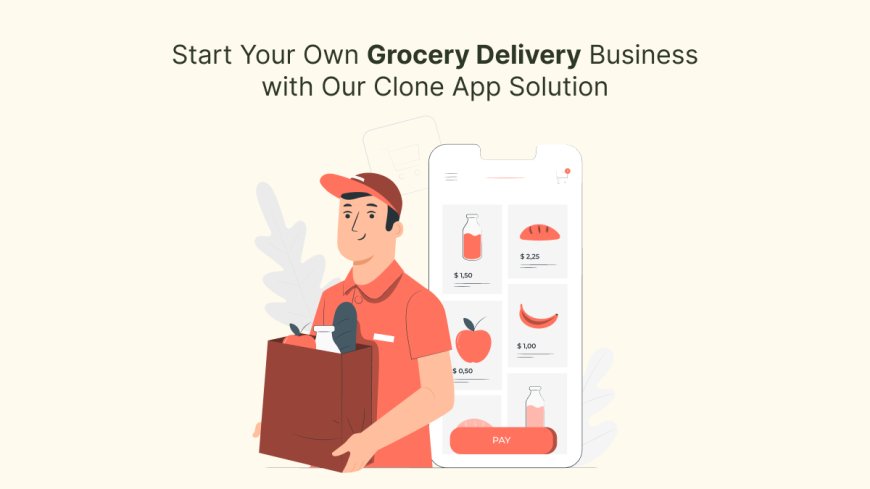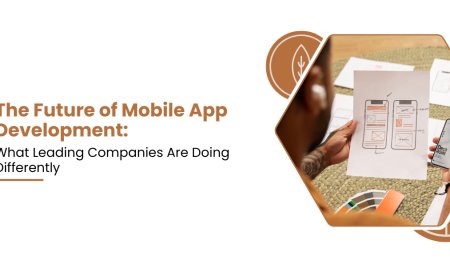Start Your Own Grocery Delivery Business with Our Clone App Solution
Launch your grocery delivery business fast with our scalable clone app solution. Packed with key features, it helps startups grow quickly in the on-demand market.

In todays fast-paced world, consumers demand convenienceand grocery delivery apps are answering that call. Starting a grocery delivery business no longer requires building technology from scratch. With the rise of grocery delivery app development, entrepreneurs and startups can now use powerful clone app solutions to launch faster, serve customers better, and scale efficiently. In this blog, well explore how to start a successful grocery delivery business using a ready-made clone app solution, the key features it should include, and how it helps drive profitability in the competitive on-demand market.
Why Launch a Grocery Delivery Business in 2025?
The grocery delivery market has seen explosive growth, with the global industry expected to exceed $1 trillion in the coming years. Post-pandemic consumer habits, increasing smartphone usage, and the convenience of door-to-door delivery have made on-demand grocery services a necessity rather than a luxury.
For startups and local entrepreneurs, this is a massive opportunity. But competing with giants like Instacart, BigBasket, or Blinkit requires both speed and innovation. Thats where grocery delivery clone apps come inallowing you to enter the market with proven technology and business models.
What Is a Grocery Delivery Clone App?
A grocery delivery clone app is a pre-built software solution modeled after successful apps like Instacart or BigBasket. It includes customer apps, delivery agent apps, and admin panels, ready to be customized with your branding and business logic. These solutions are white-labeled, scalable, and optimized for fast deployment.
Instead of spending months (and a fortune) on development, you get a tested and reliable app that you can launch in a matter of weeks.
Key Features of Our Grocery Delivery Clone App
A successful grocery delivery app must offer seamless experiences for customers, delivery agents, and business owners. Here are the essential features that make our solution stand out:
Customer App Features
- Real-Time Search and Filters: Users can search for groceries by category, brand, or keyword with filters for price, offers, and ratings.
- Live Order Tracking: Customers can track the status and live location of their grocery delivery.
- Flexible Payment Options: Includes credit/debit cards, wallets, UPI, and COD support.
- Scheduled Deliveries: Allows customers to schedule delivery for a later time or date.
- Reorder with One Click: Customers can quickly reorder previously purchased items.
Delivery Agent App Features
- Delivery Alerts & Route Optimization: Drivers get alerts for new orders with optimized delivery routes via GPS integration.
- Earnings & Ratings Dashboard: Drivers can view their completed orders, earnings, and customer ratings in real time.
- Availability Toggle: Delivery agents can mark themselves available/unavailable based on working hours.
Admin Panel Features
- Vendor Management: Easily manage grocery stores, add/remove vendors, set commissions, and manage store inventory.
- Real-Time Analytics: Track orders, revenue, user activity, and delivery status through powerful dashboards.
- Offers & Coupons: Create and manage promotional campaigns, referral discounts, and loyalty points.
Business Models Supported by Our Clone App
Whether youre a single vendor, multi-store aggregator, or planning hyperlocal delivery, our grocery delivery clone app is built to support various models:
- Single Vendor Model: Ideal for local grocery stores wanting to expand online without relying on aggregators.
- Multi-Vendor Marketplace: Great for startups aiming to list multiple stores and generate revenue through commissions.
- Dark Store Model: Use centralized micro-warehouses to fulfill orders efficiently in urban areas.
Monetization Strategies for Your Grocery Delivery Business
To make your grocery delivery app profitable, here are some effective monetization models:
- Commission Per Order: Charge vendors a percentage per completed order.
- Delivery Charges: Apply dynamic delivery fees based on location and time slots.
- Surge Pricing: Implement higher delivery charges during peak hours or high demand.
- Subscription Plans: Offer customers premium benefits like free delivery or early access to deals for a monthly fee.
- In-App Promotions: Sell advertising space or sponsored placements to vendors within the app.
Why Choose a Clone App Over Building from Scratch?
Lets face itbuilding a grocery delivery platform from the ground up is costly and time-consuming. By using a white-label grocery delivery clone app, you eliminate guesswork and reduce development time drastically. Heres how it benefits your business:
- Faster Go-to-Market: Launch within weeks, not months.
- Proven UX/UI: Designed after successful apps to deliver intuitive user experience.
- Lower Development Costs: Save on tech stack, hiring, and QA processes.
- Scalability: Easily handle growing user base, vendors, and delivery partners.
How to Launch Your Grocery Delivery Business
Launching your business with a clone app is simple if you follow these strategic steps:
Step 1: Define Your Niche
Decide whether you're targeting urban grocery delivery, organic groceries, hyperlocal delivery, or a combination of services.
Read More: Take the Lead on the Market with Grocery Delivery App Solution!
Step 2: Choose a Reliable Development Partner
Look for an experienced clone app development company that offers post-launch support, robust features, and customization options.
Step 3: Set Up Vendor Partnerships
Partner with local grocery stores or suppliers to populate your platform with inventory and ensure product availability.
Step 4: Configure the App and Go Live
Customize the apps branding, payment gateways, delivery zones, and commissions, then launch on app stores.
Step 5: Market Aggressively
Use SEO, local ads, influencer partnerships, and referral campaigns to attract customers and delivery agents quickly.
Scaling Your Grocery Delivery App
Once your business gains traction, focus on these strategies to scale:
- Add More Vendors and Categories: Include pharmacy, pet supplies, or household items to increase cart value.
- Expand to New Cities: Replicate your model in nearby urban or suburban areas.
- Introduce AI-Based Recommendations: Personalize product suggestions to boost average order value.
- Automate Warehousing and Inventory: Use integrated systems for stock tracking and fulfillment automation.
Conclusion
Launching a grocery delivery business has never been more accessible, thanks to reliable clone app solutions. With the right features, a scalable tech foundation, and solid market strategies, you can build a profitable venture that meets modern customer demands. Choosing a trusted clone app development company is your first step toward long-term success in the on-demand grocery space.
FAQs
1. How long does it take to launch a grocery delivery app using a clone solution?
You can go live within 2 to 4 weeks, depending on customization and integrations.
2. Can I customize the design and features of the app?
Yes, our clone apps are fully white-labeled and support design and feature customization.
3. Whats the cost of a grocery delivery clone app?
The price depends on your required features, app platforms, and scale. Entry-level packages are budget-friendly for startups.
4. Does the app support multiple languages and currencies?
Yes, our solutions offer multi-language and multi-currency support to help you localize effectively.
5. Is the app scalable for large user bases or multi-city operations?
Absolutely. Our clone app architecture is built to handle thousands of users and scale across multiple cities.























